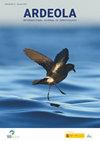Redness Variation in the Eurasian Scops-Owl Otus scops is Due to Pheomelanin But is Not Associated with Variation in the Melanocortin-1 Receptor Gene (MC1R)
IF 1.2
4区 生物学
Q2 ORNITHOLOGY
引用次数: 6
Abstract
Summary. Melanin-based colorations in birds constitute a paradigm for the study of the molecular basis of phenotypic variation. Variation in the melanocortin-1 receptor (MCR1) gene, a key regulator of melanin synthesis in feather melanocytes, can lead to changes in the production of melanin and hence in feather colour. Here we investigate the proximate mechanisms behind colour plumage polymorphism in the Eurasian Scops-owl Otus scops, a species showing pronounced variation in the degree of redness. Although eumelanin pigment was three times more abundant than pheomelanin pigments, the degree of plumage redness was more strongly associated with the amount of pheomelanin than eumelanin pigments. We detected only one synonymous substitution and one non-synonymous substitution in MC1R which were, however, not associated with variation in plumage coloration. Redness variation in Eurasian Scops-Owls is primarily due to variation in pheomelanin, and to genes or regulatory elements other than MCR1. —Avilés, J.M., Cruz-Miralles, A., Ducrest, A.-L., Simon, C., Roulin, A., Wakamatsu, K. & Parejo, D. (2020). Redness variation in the Eurasian Scops-owl Otus scops is due to pheomelanin but is not associated with variation in the melanocortin-1 receptor gene (mc1r). Ardeola, 67: 3-13.欧亚范围-猫头鹰范围的红色变异是由黑素引起的,但与黑素皮质素-1受体基因(MC1R)的变异无关。
总结。鸟类中基于黑色素的着色构成了表型变异分子基础研究的范例。黑素皮质素-1受体(melanocortin-1 receptor, MCR1)基因是羽毛黑色素细胞中黑色素合成的关键调节因子,其变异可导致黑色素产生的变化,从而改变羽毛的颜色。在这里,我们研究了欧亚范围猫头鹰(Otus scops)颜色羽毛多态性背后的近似机制,该物种在红色程度上表现出明显的差异。虽然真黑素色素的含量是黑色素色素的三倍,但与真黑素相比,羽毛的发红程度与黑色素的含量关系更密切。我们在MC1R中只检测到一个同义替换和一个非同义替换,但它们与羽毛颜色的变化无关。欧亚范围猫头鹰的红色变异主要是由于黑色素的变异,以及MCR1以外的基因或调控元件的变异。-阿维尔·卡兹,j.m.,克鲁兹-米拉莱斯,a.a,杜克雷斯特,a.l。, Simon, C, rolin, A., Wakamatsu, K.和Parejo, D.(2020)。欧亚乌斯鸮的红色变异是由黑色素引起的,但与黑素皮质素-1受体基因(mc1r)的变异无关。Ardeola, 67: 3-13。
本文章由计算机程序翻译,如有差异,请以英文原文为准。
求助全文
约1分钟内获得全文
求助全文
来源期刊
CiteScore
2.30
自引率
6.20%
发文量
16
审稿时长
>12 weeks
期刊介绍:
Ardeola: International Journal of Ornithology is the scientific journal of SEO/BirdLife, the Spanish Ornithological Society. The journal had a regional focus when it was first published, in 1954. Since then, and particular during the past two decades, the journal has expanded its thematic and geographical scope. It is now a fully international forum for research on all aspects of ornithology. We thus welcome studies within the fields of basic biology, ecology, behaviour, conservation and biogeography, especially those arising from hypothesis-based research. Although we have a long publication history of Mediterranean and Neotropical studies, we accept papers on investigations worldwide.
Each volume of Ardeola has two parts, published annually in January and July. The main body of each issue comprises full-length original articles (Papersand Review articles) and shorter notes on methodology or stimulating findings (Short Communications). The publication language is English, with summaries, figure legends and table captions also in Spanish. Ardeolaalso publishes critical Book Reviewsand PhD-Dissertation Summaries; summarising ornithological theses defended in Spain. Finally there are two Spanish-language sections, Ornithological News; summarising significant recent observations of birds in Spain, and Observations of Rare Birds in Spain, the annual reports of the Spanish Rarities Committee.

 求助内容:
求助内容: 应助结果提醒方式:
应助结果提醒方式:


